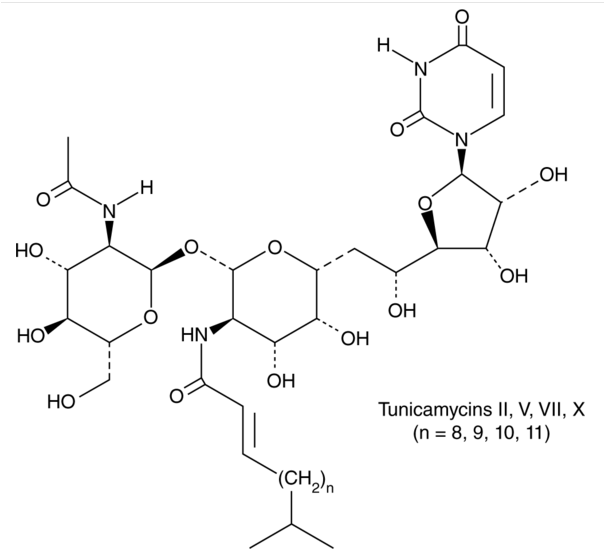Tunicamycin Mixture |
| Catalog No.GC16738 |
Antibiotic,inhibits GlcNAc phosphotransferase (GPT)
Products are for research use only. Not for human use. We do not sell to patients.

Cas No.: 11089-65-9
Sample solution is provided at 25 µL, 10mM.
Tunicamycin (TCM or TM) [1] [2] is an antibiotic. It can block the reaction between UDP-N-acetylglucosamine and dolichol phosphate in the first step of glycoprotein synthesis and thus inhibit the synthesis of all N-linked glycoproteins, finally cause endoplasmic reticulum (ER) stress [3]. In Bacillus subtilis cells, the IC50 for TCM to inhibit the formation of dolichyl pyrophosphoryl N-acetylglucosamine (Dol-p-p-GlcNAc) is 0.03 μg/ml [2].
The ER stress response is a potent, evolutionarily conserved response to cellular metabolic stress and misfolded proteins. ER stress is induced by disruption of ER functions, such as transport to the Golgi complex or protein glycosylation, or by disturbances in the ER lumen environment, such as redox status or altered calcium homeostasis [3].
In RAW264.7 cells, tunicamycin significantly reduced LPS-induced nitrite release/production and attenuated the expression of mRNAs and hence proteins of COX-2 and iNOS. In addition, tunicamycin at a concentration of 0.5 μg/ml did not have any effect on cell survival/proliferation, but at 48h tunicamycin provided protection against activation-induced macrophage cell death. In a concentration-dependent manner, tunicamycin reduced COX-2 and iNOS protein expressions in response to LPS and induced a concurrent increase in 78-kDa glucose-regulated protein (GRP78), an ER chaperone [3].
In the small intestine of wild-type mice, tunicamycin elevated expression levels of suppressed 1370 probes and 1291 probes by >2 fold. In the small intestine of Nrf 2 (-/-) mice, tunicamycin inhibited 2024 probes and induced 3471 probes by >2 fold. Compared with results of small intestine samples, in wild-type mice liver, less well-defined genes were either suppressed (943) or elevated (750) >2 fold by tunicamycin; whereas in Nrf2 (-/-) mice liver, 3170 genes were inhibited or 39 well-defined genes were induced [1].
Reference:
[1]. Sujit Nair, Changjiang Xu, Guoxiang Shen, et al. Toxicogenomics of Endoplasmic Reticulum stress inducer Tunicamycin in the Small Intestine and Liver of Nrf2 Knockout and C57BL/6J Mice. Toxicol Lett., 2007, 168(1):21-39.
[2]. Masatoshi Inukai, Fujio Isono and Akira Takatsuki. Selective Inhibition of the Bacterial Translocase Reaction in Peptidoglycan Synthesis by Mureidomycins. Antimicrobial Agents and Chemotherapy, 1993, 37(5): 980-983.
[3]. Song-YiKim, Ji-SunHwang and Inn-OcHan. Tunicamycin inhibits Toll-like receptor-activated inflammation in RAW264.7 cells by suppression of NF-κB and c-Junactivity via a mechanism that is independent of ER-stress and N-glycosylation. European Journal of Pharmacology, 2013, 721: 294-300.
Average Rating: 5 (Based on Reviews and 22 reference(s) in Google Scholar.)
GLPBIO products are for RESEARCH USE ONLY. Please make sure your review or question is research based.
Required fields are marked with *




